The Proto-Indo-Europeans are a hypothetical prehistoric ethnolinguistic group of Eurasia who spoke Proto-Indo-European (PIE), the reconstructed common ancestor of the Indo-European language family.

The historical Vedic religion, also called Vedicism or Vedism, and sometimes ancient Hinduism or Vedic Hinduism, constituted the religious ideas and practices prevalent amongst some of the Indo-Aryan peoples of the northwest Indian subcontinent during the Vedic period. These ideas and practices are found in the Vedic texts, and some Vedic rituals are still practiced today. The Vedic religion is one of the major traditions which shaped modern Hinduism, though present-day Hinduism is significantly different from the historical Vedic religion.

The Elamo-Dravidian language family is a hypothesised language family that links the Elamite language of ancient Elam to the Dravidian languages of South Asia. The latest version (2015) of the hypothesis entails a reclassification of Brahui as being more closely related to Elamite than to the remaining Dravidian languages. Linguist David McAlpin has been a chief proponent of the Elamo-Dravidian hypothesis, followed by Franklin Southworth as the other major supporter. The hypothesis has gained attention in academic circles, but has been subject to serious criticism by linguists, and remains only one of several possible scenarios for the origins of the Dravidian languages. Elamite is generally accepted by scholars to be a language isolate, unrelated to any other known language.
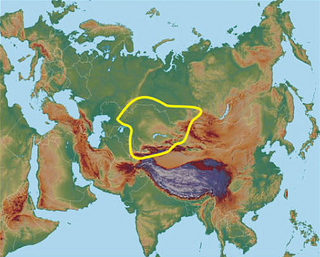
The Andronovo culture is a collection of similar local Late Bronze Age cultures that flourished c. 2000–1150 BC, spanning from the southern Urals to the upper Yenisei River in central Siberia and western Xinjiang in the east. In the south, the Andronovo sites reached Tajikistan and Uzbekistan. It is agreed among scholars that the Andronovo culture was Indo-Iranian. Some researchers have preferred to term it an archaeological complex or archaeological horizon.

The Indo-Iranian peoples, also known as Ā́rya or Aryans from their self-designation, were a group of Indo-European speaking peoples who brought the Indo-Iranian languages to major parts of Eurasia in waves from the first part of the 2nd millennium BC onwards. They eventually branched out into the Iranian peoples and Indo-Aryan peoples.
The Indo-Aryan migrations were the migrations into the Indian subcontinent of Indo-Aryan peoples, an ethnolinguistic group that spoke Indo-Aryan languages. These are the predominant languages of today's Bangladesh, Maldives, Nepal, North India, Pakistan, and Sri Lanka.
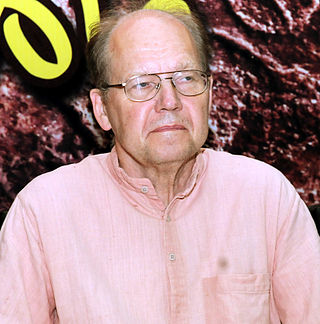
Asko Heikki Siegfried Parpola is a Finnish Indologist, current professor emeritus of Indology at the University of Helsinki. He specializes in the Indus Valley Civilization, specifically the study of the Indus script.

The horse has been present in the Indian subcontinent from at least the middle of the second millennium BC, more than two millennia after its domestication in Central Asia. The earliest uncontroversial evidence of horse remains on the Indian Subcontinent date to the early Swat culture. While horse remains and related artifacts have been found in Late Harappan sites, indicating that horses may have been present at Late Harappan times, horses did not play an essential role in the Harappan civilisation, in contrast to the Vedic period. The importance of the horse for the Indo-Aryans is indicated by the Sanskrit word Ashva, "horse," which is often mentioned in the Vedas and Hindu scriptures.
The Armenian hypothesis, also known as the Near Eastern model, is a theory of the Proto-Indo-European homeland, initially proposed by linguists Tamaz V. Gamkrelidze and Vyacheslav Ivanov in the early 1980s, which suggests that the Proto-Indo-European language was spoken during the 5th–4th millennia BC in "eastern Anatolia, the southern Caucasus, and northern Mesopotamia".
Vedic Sanskrit has a number of linguistic features which are alien to most other Indo-European languages. Prominent examples include: phonologically, the introduction of retroflexes, which alternate with dentals, and morphologically, the formation of gerunds. Some philologists attribute such features, as well as the presence of non-Indo-European vocabulary, to a local substratum of languages encountered by Indo-Aryan peoples in Central Asia (Bactria-Marghiana) and within the Indian subcontinent during Indo-Aryan migrations, including the Dravidian languages.
Indigenous Aryanism, also known as the Indigenous Aryans theory (IAT) and the Out of India theory (OIT), is the conviction that the Aryans are indigenous to the Indian subcontinent, and that the Indo-European languages radiated out from a homeland in India into their present locations. It is a "religio-nationalistic" view on Indian history, and propagated as an alternative to the established migration model, which considers the Pontic–Caspian steppe to be the area of origin of the Indo-European languages.
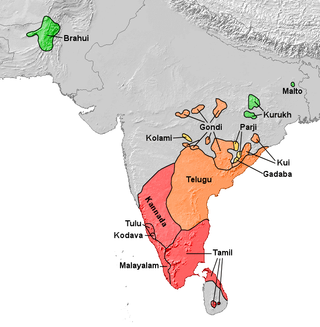
The Dravidian peoples, Dravidian-speakers or Dravidians, are a collection of ethnolinguistic groups native to South Asia who speak Dravidian languages. There are around 250 million native speakers of Dravidian languages. Dravidian speakers form the majority of the population of South India and are natively found in India, Pakistan, Afghanistan, Bangladesh, the Maldives, Nepal, Bhutan and Sri Lanka. Dravidian peoples are also present in Singapore, Mauritius, Malaysia, France, South Africa, Myanmar, East Africa, the Caribbean, and the United Arab Emirates through recent migration.

The Proto-Indo-European homeland was the prehistoric linguistic homeland of the Proto-Indo-European language (PIE). From this region, its speakers migrated east and west, and formed the proto-communities of the different branches of the Indo-European language family.

The Vedic period, or the Vedic age, is the period in the late Bronze Age and early Iron Age of the history of India when the Vedic literature, including the Vedas, was composed in the northern Indian subcontinent, between the end of the urban Indus Valley Civilisation and a second urbanisation, which began in the central Indo-Gangetic Plain c. 600 BCE. The Vedas are liturgical texts which formed the basis of the influential Brahmanical ideology, which developed in the Kuru Kingdom, a tribal union of several Indo-Aryan tribes. The Vedas contain details of life during this period that have been interpreted to be historical and constitute the primary sources for understanding the period. These documents, alongside the corresponding archaeological record, allow for the evolution of the Indo-Aryan and Vedic culture to be traced and inferred.
Aryan, or Arya in Proto-Indo-Iranian, is a term originating from the ethno-cultural self-designation of the Indo-Iranians, and later Iranians and Indo-Aryans. It stood in contrast to nearby outsiders, whom they designated as non-Aryan. In ancient Iran and India, the term was used by the Indo-Aryan peoples of the Vedic period, both as an endonym and in reference to a region called Aryavarta, where their culture emerged. Similarly, according to the Avesta, the Iranian peoples used the term to designate themselves as an ethnic group and to refer to a region called Airyanem Vaejah, which was their mythical homeland. The word stem also forms the etymological source of place names like Alania and Iran.

The peopling of India refers to the migration of Homo sapiens into the Indian subcontinent. Anatomically modern humans settled India in multiple waves of early migrations, over tens of millennia. The first migrants came with the Coastal Migration/Southern Dispersal 65,000 years ago, whereafter complex migrations within South and Southeast Asia took place. West Asian (Iranian) hunter-gatherers migrated to South Asia after the Last Glacial Period but before the onset of farming. Together with ancient South Asian hunter-gatherers they formed the population of the Indus Valley Civilisation (IVC).
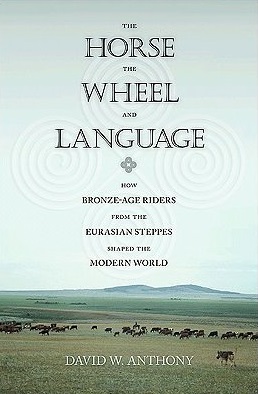
The Horse, the Wheel, and Language: How Bronze-Age Riders from the Eurasian Steppes Shaped the Modern World is a 2007 book by the anthropologist David W. Anthony, in which the author describes his "revised Kurgan theory." He explores the origins and spread of the Indo-European languages from the Pontic–Caspian steppe throughout Western Europe, Central Asia, and South Asia. He shows how the domesticated horse and the invention of the wheel mobilized the steppe herding societies in the Eurasian Steppe, and combined with the introduction of bronze technology and new social structures of patron-client relationships gave an advantage to the Indo-European societies. The book won the Society for American Archaeology's 2010 Book Award.
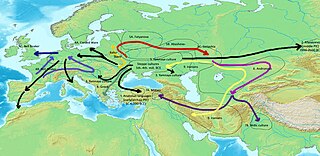
The Indo-European migrations are hypothesized migrations of peoples who spoke Proto-Indo-European (PIE) and the derived Indo-European languages, which took place from around 4000 to 1000 BCE, potentially explaining how these related languages came to be spoken across a large area of Eurasia spanning from the Indian subcontinent and Iranian plateau to Atlantic Europe, in a process of cultural diffusion.

Vasant Shinde is an Indian archaeologist, who has done excavations at Rakhigarhi from 2011 to 2016. He was the first author on the long-awaited 2019 paper "An Ancient Harappan Genome Lacks Ancestry from Steppe Pastoralists or Iranian Farmers," on DNA-research on a single skeleton from Rakhigarhi which shows that the people of the Indus Valley Civilisation had no steppe (Indo-Aryan) genetic ancestry, in line with the Indo-Aryan migration theory. The day after the publication Shinde publicly endorsed the Out of India theory, contradicting the conclusions of this paper.















